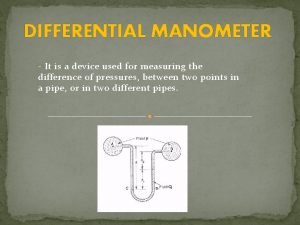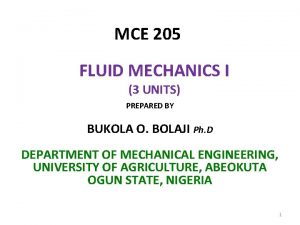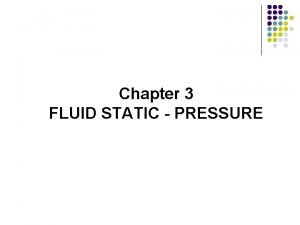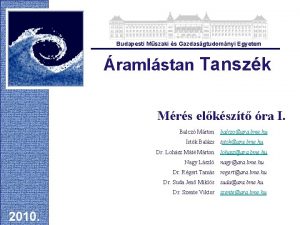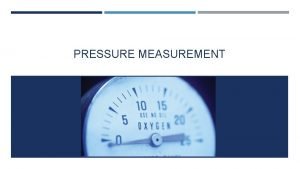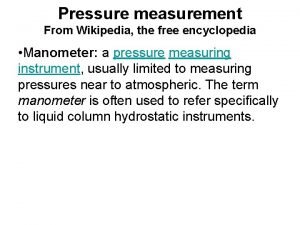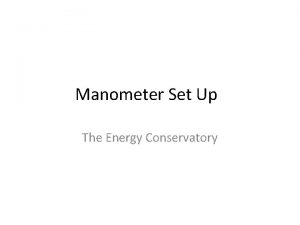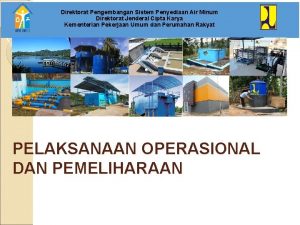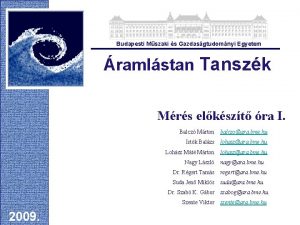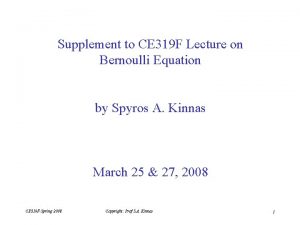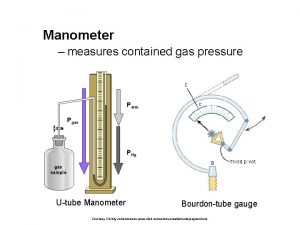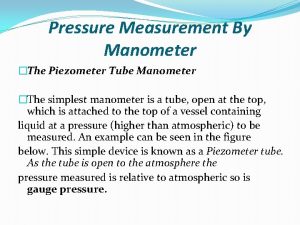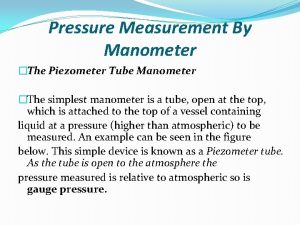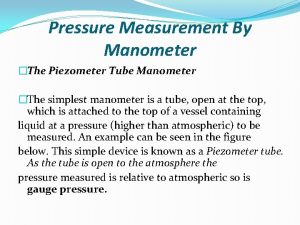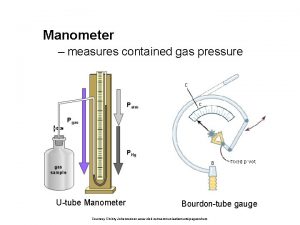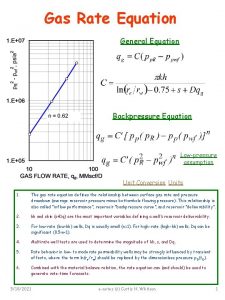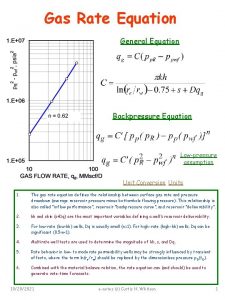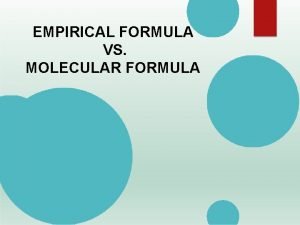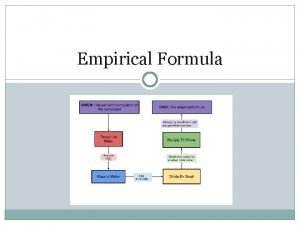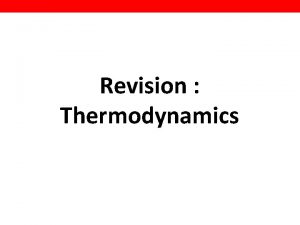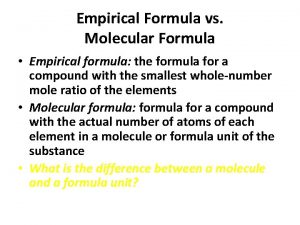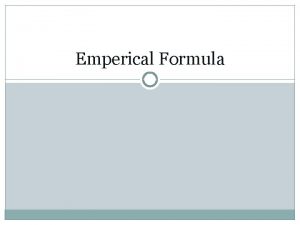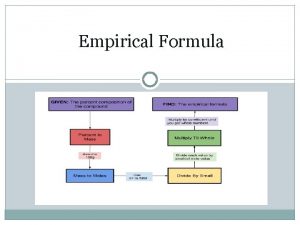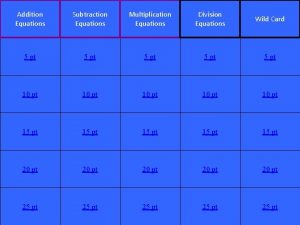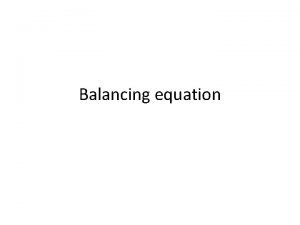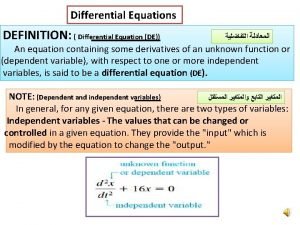Manometer Equations General Manometer Equation The formula that




























- Slides: 28

Manometer Equations

General Manometer Equation The formula that relates the pressure difference P 1 – P 2 to the difference in manometer fluid levels is based on the principle that the fluid pressure must be the same at any two points at the same height in a continuous fluid. In particular, the pressure at the height of the lower surface of a manometer fluid is the same in both arms of the manometer. the general manometer equation In a differential manometer, fluids 1 and 2 are the same, and consequently p 1 = p 2 = p.

Differential Manometer Equation • If either fluid 1 or 2 is a gas at a moderate pressure (e. g. , if one arm is open to the atmosphere), the density of this fluid is 100 to 1000 times lower than the density of the manometer fluid, so that the corresponding pgd term may be neglected. • If both fluids are gases, then the equation becomes P 1 – P 2 = pfgh

Manometer Formula for Gases: • If P 2 is atmospheric pressure, then the gauge pressure at point 1 is simply the difference in the levels of the manometer fluid.

Temperature and its Scales

What is Temperature? • Temperature is a physical property of a system that underlies the common notions of hot and cold; • Temperature is a property of matter. • One of the principal parameters of thermodynamics. • The unique physical property that determines the direction of heat flow between two objects placed in thermal contact. If no heat flow occurs, the two objects have the same temperature; otherwise heat flows from the hotter object to the colder object.

Definitions • It is the measurement of the AVERAGE kinetic energy of the particles of matter. • The temperature of a substance in a particular state of aggregation (solid, liquid. or gas) is a measure of the average kinetic energy possessed by the substance molecules. • A measure of its thermal state considered in reference to its power to transfer heat to other bodies. (Maxwell Definition)

Measurement • Must be determined indirectly by measuring some physical property of the substance whose value depends on temperature in a known manner. • Volume of a Fluid (thermometer) • Resistance of a metal(Resistance thermometer) • Voltage at the junction of two dissimilar metals(thermocouples) • Spectra of emitted radiations(pyrometer)

Temperature Scales

Comparison of temperature scales Can be defined in terms of any of these properties, or in terms of physical phenomena, such as freezing and boiling, that take place at fixed temperatures and pressures. • Relative Scales – Fahrenheit (°F) – Celsius (°C) • Absolute Scales – Rankine (°R) – Kelvin (K)

Physical Scales Vs Numerical Scales • "the temperature at which the resistivity of a copper wire is 1. 92 x 10 -6 ohms/cm 3 “ • "the temperature two-thirds of the way from the boiling point of water. “ • A defined temperature scale is obtained by arbitrarily assigning numerical values to two reproducibly measurable temperatures;

Temperature Scales • To construct a thermometer scale: • Select Two naturally occurring fixed events • Freezing and Boiling Point of water are normally chosen. • Then numbers are assigned to these points • Then the space in-between is divided into a fixed number of equal degrees.

• Main temperature scales • Celsius • Fahrenheit • Kelvin • Rankine

Uses of the Scales • Fahrenheit scale is used for engineering and Household purposes. • Celsius scale is universally used for all scientific measurements

The Fahrenheit Scale • The fixed points on which the Fahrenheit scale were created: A mixture of ice water and salt as the low AND The human body temperature as the high

°F Scale • Boiling point 0 F 212 became = ____ • Freezing point 0 F 32 became = _____ Absolute zero falls at -459. 67°F.

Celsius Scale ØBoiling Point = 100 0 C ØFreezing Point = 0 0 C • The original name was the • CENTIGRADE scale – In 1948 it was renamed in honor of the original creator, Anders Celsius Absolute zero (theoretically the lowest temperature attainable in nature) on this scale falls at -273. 15°e.

Absolute Scales • The Kelvin and Rankine scales are defined such that absolute zero has a value of 0 and the size of a degree is the same as a Celsius degree (Kelvin scale) or a Fahrenheit degree (Rankine scale ).

Kelvin Scale • Named for William Thomson • Who became Lord Kelvin of Largs. • His scale is based on the temperature at which all molecular movement STOPS. KE=0

Kelvin Scale and • This temperature is known as • ABSOLUTE ZERO • Absolute Zero = 0 • Boiling point of water = 373 K=100 C • Freezing point of water = 273 K=0 C

Rankine Scale • KE=0 • Incerements=Farenhite • 459. 67 R=0 F

Converting Temperatures

Conversion Factors A degree is both temperature and temp interval

Conversion Equations

Temperature Conversions • Fahrenheit to Celsius C = (F-32) x 5 9 • Celsius to Fahrenheit F= ( Cx 9 5 ) + 32

Temperature Conversions Cont. Celsius to Kelvin: K = C + 273 Kelvin to Celsius: C = K - 273

Quick Conversion Celsius to Fahrenheit: Double the Celsius then Add 30.

Find the number of Celsius degrees between 32°F and 212°F
 800 n
800 n Manomater
Manomater Phân độ lown
Phân độ lown Block xoang nhĩ là gì
Block xoang nhĩ là gì Thơ thất ngôn tứ tuyệt đường luật
Thơ thất ngôn tứ tuyệt đường luật Thơ thất ngôn tứ tuyệt đường luật
Thơ thất ngôn tứ tuyệt đường luật Chiến lược kinh doanh quốc tế của walmart
Chiến lược kinh doanh quốc tế của walmart Tìm vết của mặt phẳng
Tìm vết của mặt phẳng Hãy nói thật ít để làm được nhiều
Hãy nói thật ít để làm được nhiều Tôn thất thuyết là ai
Tôn thất thuyết là ai Gây tê cơ vuông thắt lưng
Gây tê cơ vuông thắt lưng Sau thất bại ở hồ điển triệt
Sau thất bại ở hồ điển triệt Manometer formula
Manometer formula Pgage
Pgage The general equation for a single replacement reaction is
The general equation for a single replacement reaction is Druk verschil meten
Druk verschil meten Betz manometer
Betz manometer Pressure unit
Pressure unit Dead weight pressure gauge wikipedia
Dead weight pressure gauge wikipedia Permenaker bejana tekan
Permenaker bejana tekan Manometer
Manometer Energy conservatory
Energy conservatory Konstruksi sumur bor
Konstruksi sumur bor Christiaan huygens manometer
Christiaan huygens manometer Mérőperem
Mérőperem Manometer
Manometer A mercury manometer is connected to an air duct
A mercury manometer is connected to an air duct Ketelitian speedometer
Ketelitian speedometer Manometer applet
Manometer applet

